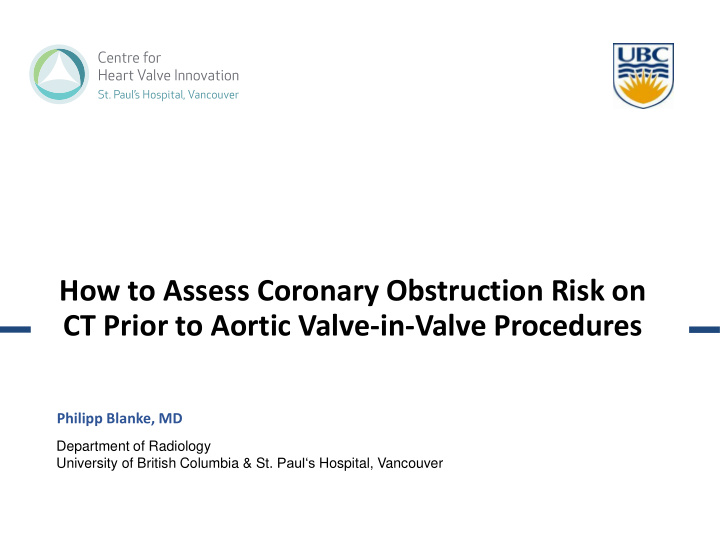



How to Assess Coronary Obstruction Risk on CT Prior to Aortic Valve-in-Valve Procedures Philipp Blanke, MD Department of Radiology University of British Columbia & St. Paul‘s Hospital, Vancouver
Disclosures Consultant to Edwards Lifesciences Neovasc Circle Imaging SPH Cardiac CT Core Lab, providing services to Edwards Lifesciences Neovasc Tendyne Holdings Medtronic
Coronary obstruction in Valve-in-Valve Procedures Background • 459 patients with failed surgical bioprostheses • Coronary obstruction in 2% of ViV procedures ( 3.5% 2012 ) • Predispoing valve types: internally stented Mitroflow, Trifecta, stentless Dvir et al. 2012, Dvir et al. 2014
Complications Remain- Ostial Coronary Obstruction Center #29, case#7 Sorin Freedom Stentless 21mm (ID 19mm) Balloon Valvuloplasty before attempted CoreValve implantation Center #30, case#3 Mitroflow 25mm (ID 21mm) Tranapical Edwards-SAPIEN 23mm Center #13, case#4 Sorin Freedom Stentless 23mm (ID 21mm) Transfemoral CoreValve 26mm Center #37, case#9 Mitroflow 21mm (ID 17.3mm) Transapical Edwards-SAPIEN 23mm Center #27, case#3 CryoLife O’Brien (stentless) 25mm (ID 23mm) Transfemoral CoreValve 29mm Center #34, case#6 Mitroflow 21mm (ID 17.3mm) Tranfemoral CoreValve 26mm Center #11, case#11 Mosaic 21mm (ID 18.5mm) Courtesy of Danny Dvir/VIVID Registry Transapical Edwards-SAPIEN 23mm
Coronary obstruction in Valve-in-Valve Procedures Valve design Mitroflow #27 in an aortic root model Valve-in-Valve with SAPIEN 29mm Dvir et al. 2014
Coronary obstruction in Valve-in-Valve Procedures Potential risk factors • Anatomic factors • Narrow sinotubular junction/low sinus height • Narrow sinuses of Valsalva • Previous root repair (eg. root graft and coronary reimplantation) • Low-lying coronary ostia • Bioprosthetic valve factors • Supra-annular position vs. Intra-annular • High leaflet profile • Internal stent frame (eg. MitroFlow, Trifecta) • No stent frame (homograft, stentless valves) • Bulky leaflets • Transcatheter valve factors • Extended sealing cuff • High implantation Dvir et al. 2014
Assessment for Valve-in-Valve Procedures Anatomical issues and potential measurements Common native root anatomy Distortion of Anatomy measures: • Tilting of the surgical • prosthesis Coronary artery height versus • • Lower coronary height Sinus of Valsalva with • Sinus height Prediction of the the proximity of the coronary ostia to the anticipated final position of the displaced bioprosthetic leaflets after THV implantation
Assessment for Valve-in-Valve Procedures Virtual THV to Coronary (VTC) distance Dvir et al. 2014, Blanke et al. 2016
Assessment for Valve-in-Valve Procedures Virtual THV to Coronary (VTC) distance Blanke et al. JCCT 2016
Assessment for Valve-in-Valve Procedures Virtual THV to Coronary (VTC) distance Blanke et al. JCCT 2016
Assessment for Valve-in-Valve Procedures Virtual THV to Coronary (VTC) distance Advanced postprocessing Pay attention to STJ above ostium as sealing may occur up there! Blanke et al. JCCT 2016
Assessment for Valve-in-Valve Procedures Workflow
Assessment for Valve-in-Valve Procedures Virtual THV to Coronary (VTC) distance Non-contrast images are sufficient, but need to be gated!
Assessment for Valve-in-Valve Procedures Example Dvir et al. 2014
Assessment for Valve-in-Valve Procedures Virtual THV to Coronary (VTC) distance Magic number – 4mm? VIVID Registry, presented at TCT 2016 (Ribiero et al)
Recommend
More recommend